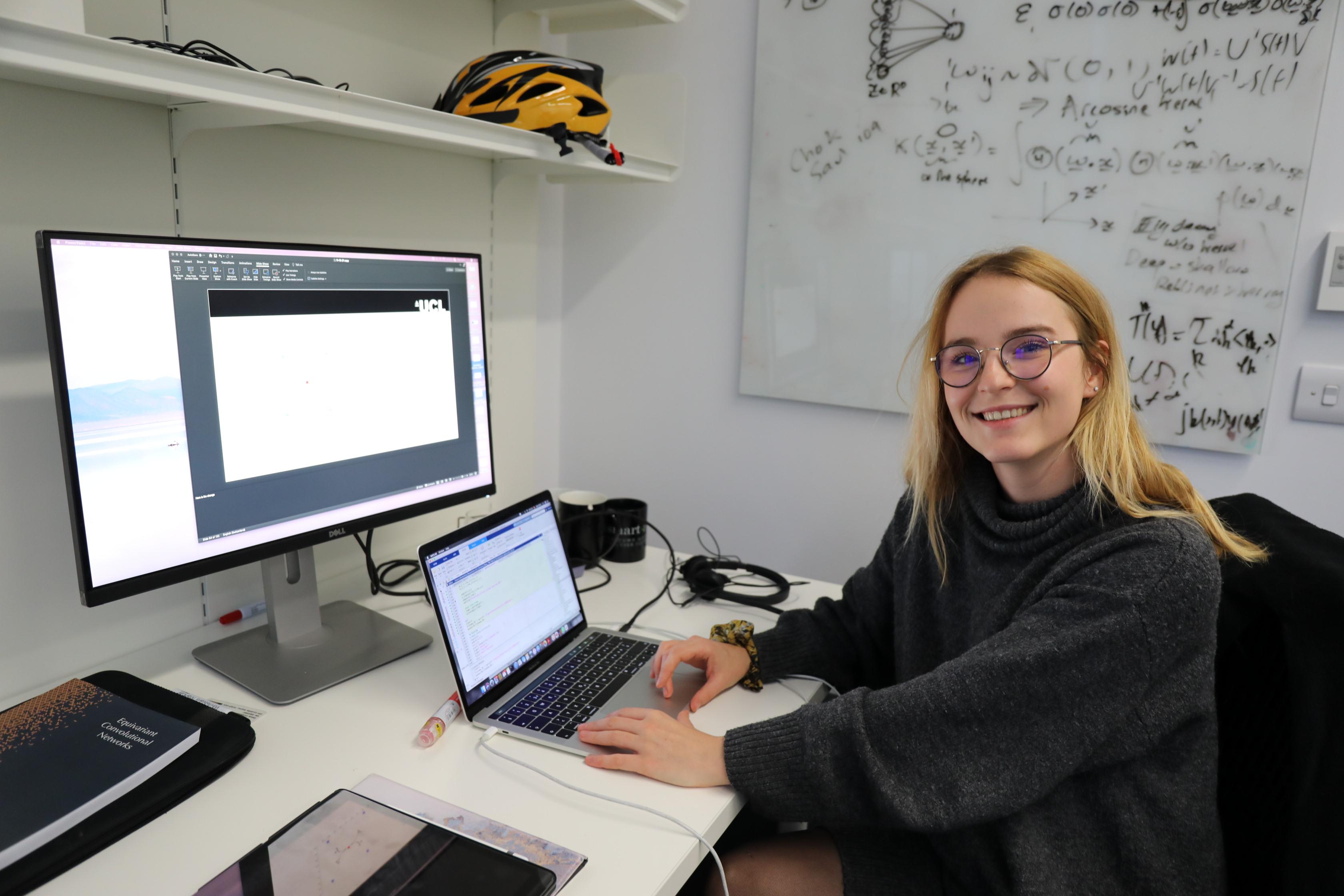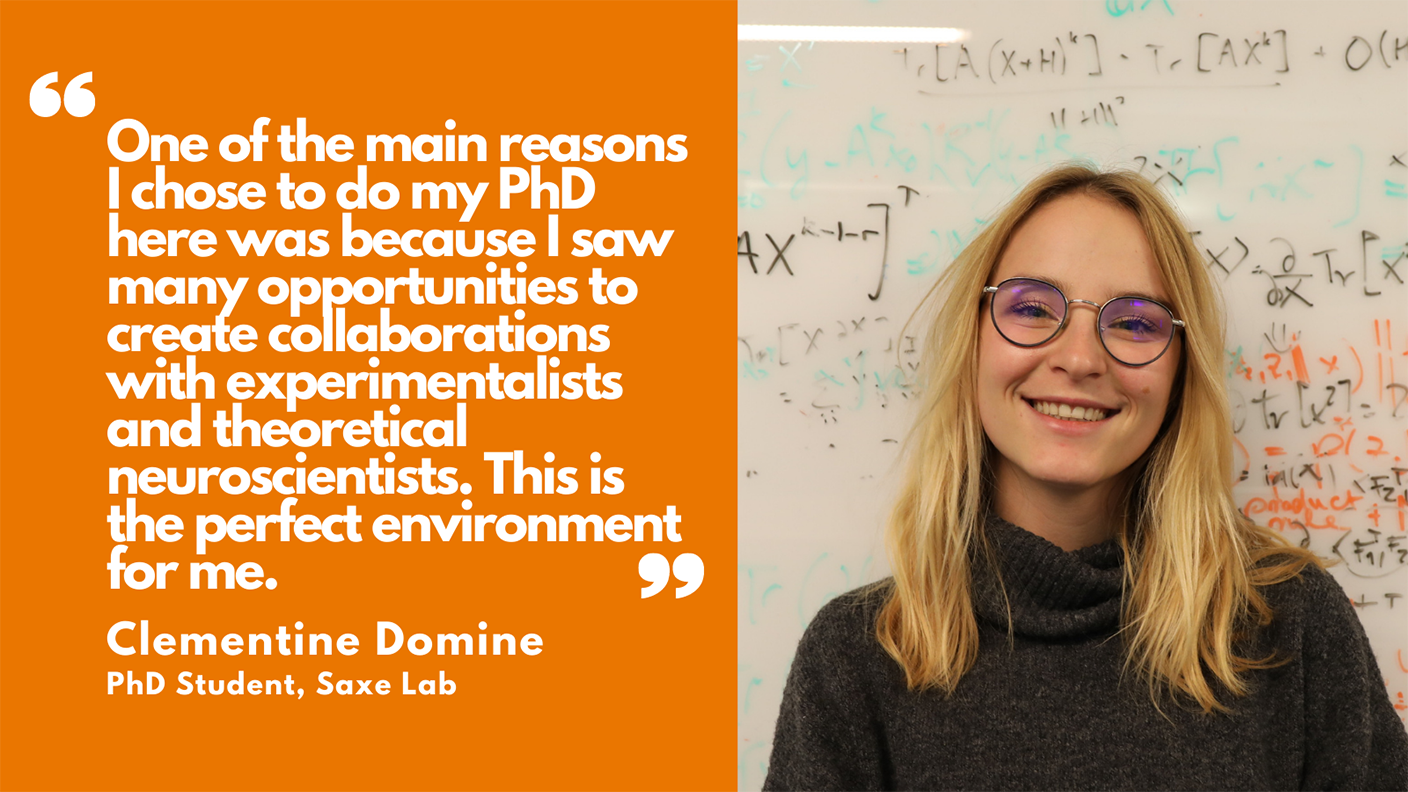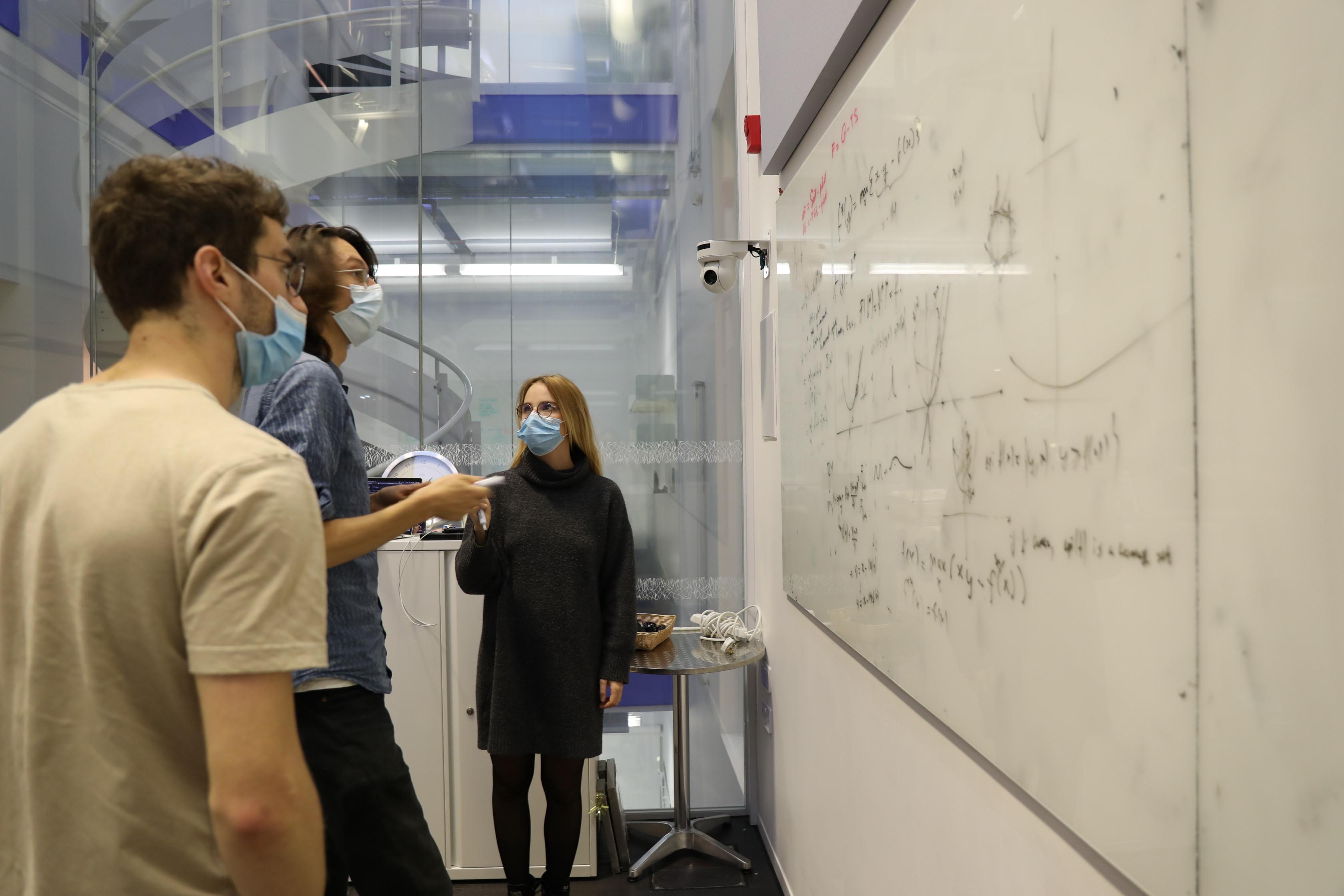
Embracing the intersection between neuroscience, physics, and art
An interview with Clementine Domine conducted by April Cashin-Garbutt
Clementine Domine shares her journey in science, from studying theoretical physics at undergraduate level to progressing a PhD in the Saxe lab at the Gatsby Computational Neuroscience Unit (GCNU) and SWC.
Did you always want to be a neuroscientist?
I always knew I wanted to be a scientist. My grandmother was a physics teacher, which was relatively uncommon in those days, and she was the first woman in science I came across. I remember that as a child, she gave me an electrical board and told me about how it worked. She played a huge role in sparking my interest in understanding what was around me. To this day, she is one of my greatest role models.
In high school, I hesitated between studying for a degree in physics or neuroscience, and I didn’t know which to choose. I have always been interested in understanding the brain. I did a year-long project in high school about memory, and the idea was to create a program that would allow you to train your memory of names and faces. What I found fascinating was that the people who performed very well in the memory contest actually used techniques that could be understood in the context of the brain. For instance, they used the techniques of repetition and surprise, and interestingly, both are also known to increase plasticity in the brain. To see the connection between our human experience and what is known about the brain was quite fascinating to me.
However, I felt that physics would open more doors and give me good analytical and problem-solving skills that I could apply later on to neuroscience. I also was very interested in the fundamental questions that physics brings, such as what matter is, how did the Universe come to be, and so forth.
In my second year, my interest in neuroscience grew again because I realised that everything we understand in physics, we understand through the brain. Yet we don’t even understand the brain itself! I also felt that physics is very remote from our daily life, and the applications will be visible much later in the future. I wanted something more applicable and that had a more significant impact but kept the fundamental and fascinating questions that come with studying something like the brain.
Therefore, I started to take neuroscience courses. I then did an internship at the EPFL Blue Brain Project and an exchange at UCLA, where they offered neurophysics. This allowed me to discover the field and figure out if this was really what I wanted to do. After that, I came to the Ph.D. program here, which was a fantastic transition for me because I felt I had not explored enough neuroscience or machine learning before, even though I had the mathematical training for it. So it was the perfect opportunity for me to continue on that path I had set for myself.

Why did you choose to join Andrew Saxe’s lab?
When I joined GCNU, I was not entirely sure what I was going to do; I had already explored a few areas but knew there was a lot left for me to discover.
While I got to learn about so many new things during my first year, interestingly, I eventually stayed with my initial interest in memory and learning. I find it fascinating that our memories build from different experiences, creating our subjective perspective of life. Memories and experiences make us who we are. Understanding our different ways of thinking from this perspective could makes us more tolerant of each other.
Andrew was very interested in similar memory and learning mechanisms ideas, and I really liked his approach using very simplified models. He is quite well-known for his work on formalising the learning dynamics in linear networks. For my projects, we are taking a bottom-up approach via both exploratory coding and good theoretical formalisms driving the research. I also felt comfortable speaking with him, and his method of working fit me.
How did the COVID pandemic influence your desire to collaborate more?
During the height of the pandemic, it was more difficult to have a social life or even social interactions at work. Knowing that the Ph.D. experience can be quite lonely (as we work on our own projects for a long time), I felt the need to collaborate more. I felt I would learn a lot from collaborations, not only benefiting from social aspects but also making progress on problems as a team.
While the pandemic highlighted the need for working together, collaborations have always been something I was personally interested in and sought out. This is also one of the main reasons I chose to do my Ph.D. here because I saw many opportunities to create those collaborations with experimentalists and theoretical neuroscientists. This is the perfect environment for me.

Can you tell us about your role as a teaching assistant during Bootcamp for SWC and GCNU students?
I’m very attached to this experience because I personally want to become a professor in the future, and I value teaching a lot. To me, science is about sharing and discussing ideas. So this experience of helping new students and teaching them new things actually taught me a lot in turn. I really enjoyed it because I learned a lot from them. We also created new working relationships that might lead to collaborations and interesting discussions.
What I did on a day to day basis was: work through problems with them; try to debug things if needed; ask them conceptual questions. I also had a lot of fun preparing my lecture because I discovered an entirely new field that I had not studied before, which was cryptography. It was a lot of fun to interact with the newly entering Ph.D. students and have this experience.
In what ways are you seeing SWC and GCNU working together more?
I believe that collaborations can be sparked from the bottom, for example, Ph.D. students interacting together. This is how some of the collaborations I am involved in were created. From the little experience that we had working together during the lectures, we agreed and wanted to work together on a project. I believe, our collaboration works well because we knew each other from those first experiences. Indeed, what is challenging to know in new collaborations is whether you will work well together. Therefore, I think this is definitely a way to get good collaborations going and get students enthusiastic about working on those projects.

How have collaborations between experimental and theoretical neuroscience helped with your research interests?
The work I have done in my collaborations is very different from my research so far. This allowed me to discover something completely new and add another set of skills to my belt. We taught each other a lot of things, and it allowed me to have breadth within my own research.
Moreover, it allowed me to understand the limitations that the experimentalists face. I came to appreciate their hard and tedious work even more. I now know roughly what is measurable, to what accuracy, and how long it takes among other things. This helped me frame my thinking around testing my theoretical result experimentally.
Can you tell us about your passion for the arts – how did you choose between art and science?
That was another difficult decision. My parents allowed me to discover the world of art when I was very young, and I played music since the age of 11 or 12, specifically the electric guitar. I played in some concerts and still do. When I was in high school, I could have gone onto a Conservatory of Music and into a musical career.
I was passionate about both topics, but going into science definitely felt like a more secure career in terms of future jobs. I also personally felt that art allowed me to express myself differently and explore a more sensitive and personal part of me. If you study physics, you are used to describing the world as equations, but everything you feel is not understandable in those terms. Other ways of expression allow you to deal with this disconnect. I also wanted to keep it personal and something I could always go back to.
I feel that the arts and science are often very separated, but I try to look at science more from an art angle and vice versa. That’s why I have a blog on art and science where I reference and talk about different projects or people working in the middle of these two worlds. In my opinion, artistic and scientific research have a lot in common regarding creativity. You have to have ideas, and even if there are restrictions, you have to have innovative ideas.
For example, it is very interesting that theoretical physicists, when they try to derive equations, they are often attracted toward the simpler and most beautiful solutions. There is this quest for beauty and simplicity, which is a similar quest that artists have. Within that research process, artists and researchers have more in common than they think. There is a very nice TED talk where Murray Gell-Man uses Maxwell’s equations as an example of this idea. Although there are only four equations, they explain all the electromagnetism surrounding us. I find these equations very beautiful to derive.
Art also often helps promote scientific ideas and allows for better understanding. Through art or beautiful plots, we gain a better understanding of the science behind what we do. There are so many ways in which art and science are entangled.
What more do you think needs to be done to increase inclusivity in neuroscience?
I don’t think this question applies solely to neuroscience – but to the all field of STEM. I will mainly talk about how I think inclusivity can be increased for all gender (as it is related to my personal experiences). However, it also applies for the inclusivity of different ethnicity, sexual orientation, disability, social class, and others.
First of all, I think that an important thing to do is have more representation. For example, have more female speakers at conferences. However, we must be careful not to be adding on to their workload and creating what is known as hidden labour.
Another approach would be to reach out to younger girls to show what is accessible to them. I don’t think we get told enough. I was fortunate to have some teachers and my grandmother who put me on that path, but this is not the case for everyone.
Lastly, it is essential to work toward making the working environment comfortable. I think this is crucial to create a safe, open, and equal environment. It can be intimidating and even uncomfortable to get into a field knowing that most of your co-workers will be male. It can become more appealing if there are on-going discussions around inclusivity. Raising awareness within the workplace will create a safer and more enjoyable environment that more women will want to join and stay in.
What advice would you give to someone considering a neuroscience PhD?
There are many ways to approach neuroscience. Just because you don’t have a neuroscience background, it doesn’t mean you cannot do neuroscience in the future. If you are interested, put yourself out there, send emails, go knock on doors and people will be very happy to welcome you and talk. I think that is what’s great about neuroscience: it is so diverse that you can approach it from many different angles. There are so many things that are yet to be known, so having a different background will really benefit the field.
Find out more about the GCNU and SWC PhD programmes

